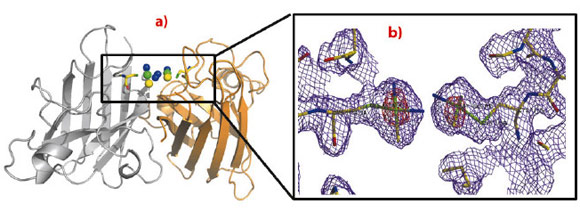- Home
- Users & Science
- Scientific Documentation
- ESRF Highlights
- ESRF Highlights 2012
- Structural biology
- Cisplatin treatment as a route to remove SOD1 aggregates in ALS
Cisplatin treatment as a route to remove SOD1 aggregates in ALS
Protein aggregates are found in the neurons of patients with several fatal, incurable neurodegenerative conditions, including amyotrophic lateral sclerosis (ALS). In ALS patients, superoxide dismutase (SOD1) aggregates, found in the cytoplasm and in mitochondria, have been repeatedly proposed as a major cause of motoneuron degeneration [1]. Although the exact mechanism of cytotoxicity is still debated, these aggregates contribute to the pathogenesis and their removal is thought to be a promising target for new therapeutic approaches.
 |
|
Fig. 28: Inhibition of formation of apo SOD1 high molecular weight oligomers by cisplatin monitored by ThT fluorescence measurements over 9000 hours. ThT fluorescence for 0.1 mM apo hSOD1 ( |
It was previously shown that these aggregates are the result of the disulphide bond formation between SOD1 molecules involving the two free cysteines that are normally reduced in native conditions [2, 3]. In the present work, we show that cisplatin (cisPt), a drug commonly employed in cancer treatment, is able to solubilise aggregates of SOD1 present in cell lines which overexpress ALS-related SOD1 mutants. Furthermore we have shown that cisPt inhibits the oligomerisation of human SOD1 by forming an adduct with the apo- form of the enzyme (Figure 28).The structural basis for this behaviour has been elucidated both through X-ray crystallography and X-ray absorption spectroscopy (EXAFS); in particular we have shown that a Pt(II) ion of the cisPt moiety binds the sulphur atom of the free Cys111 residue of each subunit of SOD1, thus preventing the Cys111-dependent trans oligomerisation occurring (Figure 29). The dissociation constant of this binding is 37 ± 3 μM. CisPt is also able to bind the metalated forms Cu2-Zn2 and Zn2-Zn2 of hSOD1.
The structural studies have rationalised the mode of action of cisPt against SOD1 oligomerisation in vitro. On one hand, the binding of cisPt to the solvent exposed Cys111 in SOD1 sequesters this site and prevents the formation of intermolecular disulphide bonds. On the other, the high affinity binding of cisPt to the cysteine sulphur drives the break and reduction of the intermolecular disulphide bonds in already formed oligomers, thus dissolving the aggregates. Therefore cisPt is able not only to block but also to reverse the formation of the SOD1 aggregates through selective target of Cys111, without affecting the normal functional pathway of SOD1 maturation and enzymatic activity. The present findings can contribute to the background knowledge for designing lead compounds capable of preventing SOD1 aggregation and can contribute to the development of treatments for ALS.
Principal publication and authors
L. Banci (a,b,c), I. Bertini (a,b), O. Blaevit (a), V. Calderone (a,b), F. Cantini (a,b), J. Mao (a), M. Vieru (a,c), I. Amori (d), M. Cozzolino (d) and M.T. Carrì (d,e), J Am Chem Soc. 134, 7009-7014 (2012).
(a) Magnetic Resonance Center CERM, University of Florence (Italy)
(b) Department of Chemistry, University of Florence (Italy)
(c) Fondazione Fiorgen, Florence (Italy)
(d) Fondazione Santa Lucia, IRCCS, Rome (Italy)
(e) Department of Biology, University of Rome “Tor Vergata” (Italy)
References
[1] M. Cozzolino, M.G. Pesaresi, I. Amori, C. Crosio, A. Ferri, M. Nencini and M.T. Carrì, Antioxid Redox Signal. 11, 1547-58 (2009).
[2] L. Banci, I. Bertini, M. Boca, V. Calderone, F. Cantini, S. Girotto, M. Vieru, Proc. Natl. Acad. Sci. USA 106, 6980-5 (2009).
[3] L. Banci, I. Bertini, M. Boca, S. Girotto, M. Martinelli, J.S. Valentine, M. Vieru, PLoS One 3, e1677 (2008).
 ); 0.1 mM apo hSOD1 and 0.8 mM cisplatin (
); 0.1 mM apo hSOD1 and 0.8 mM cisplatin ( ); 0.1 mM apo hSOD1 and 0.4 mM cisplatin (
); 0.1 mM apo hSOD1 and 0.4 mM cisplatin ( ); 0.1 mM apo hSOD1 and 0.2 mM cisplatin (
); 0.1 mM apo hSOD1 and 0.2 mM cisplatin ( ). Adapted with permission from J. Am. Chem. Soc. 134, 7009-7014. Copyright (2012) American Chemical Society.
). Adapted with permission from J. Am. Chem. Soc. 134, 7009-7014. Copyright (2012) American Chemical Society.



